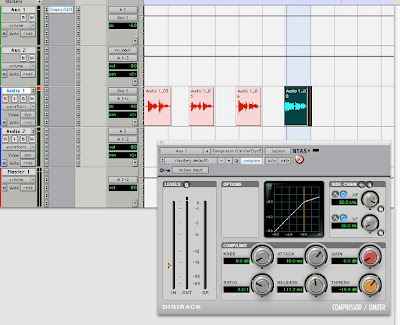aa - week 7 - vocal recording
Recording vocals.[1]
For this the Neumann U-89i microphone was used, set on a cardioid pattern with no filter or pad. A pop filter was set up about 3" away.
This was then routed through the Avalon pre-amp into pro-tools
In pro-tools I routed the initial signal through an auxiliary track to then record compression with the take.
For some reason, blogger keeps making my "large picture" not so large :( Hopefully enough information can be garnered from such..
All samples were post eq'd with about a 4dB of reduction at 3kHz. I used this on all samples because it sounded good. Perhaps it was a mic characteristic or perhaps the positioning in the room that made this a good frequency to cut.
1st and 2nd takes were about 8" from the microphone. Nothing other than a bit of "coaching" was used.
take 1 take 2
3rd take was about 6" from the mic, with the Avalon HPF set just above 130 Hz.
take 3
4th the same as the 3rd with a compression of 3:1, gain reduction of about 6 dB. As in picture above.
take 4
I found Kath's gained confidence over time, and whilst she managed to get more of an overall dynamic constancy, she still tended to lose volume over time.
Also there are noticeable unwanted mouth sounds, a bit of practice would help her delivery to gain a better recording.
5th and 6th takes were me singing :) 6 " away, 6th take featuring similar compression to earlier takes.
The 6th take (which was really about the 14th or so), shows my voice wearing out. Obviously a better singer could maintain vocal ability for longer periods, also a better dynamic stability.
take 5 take 6
All these could do with more production, but definitely the last take of Kath's voice was the most usable. This could well be due to her evolving experience at the time.
As to the takes of mine, I find them much of a muchness, neither is more preferable than the other - they both sound all right for what they are.
[1] Fieldhouse, Steve. Vocal recording technique. University of Adelaide, 24 april 2007.








